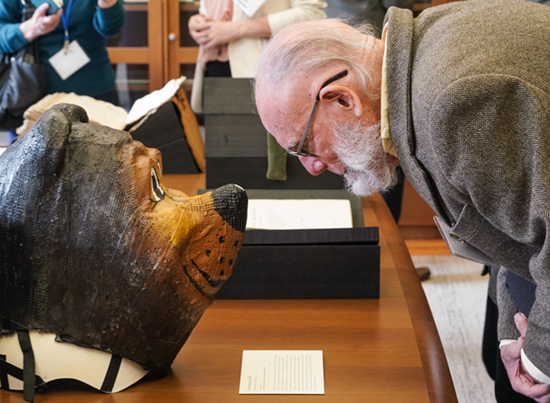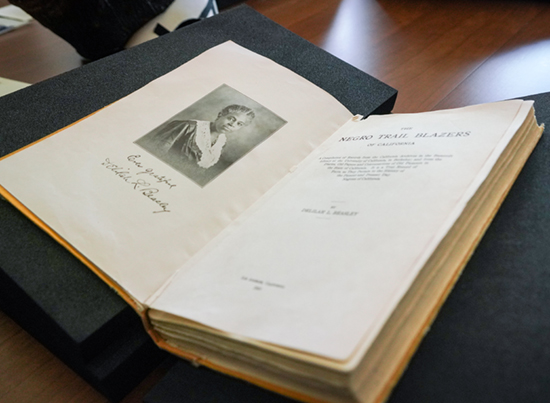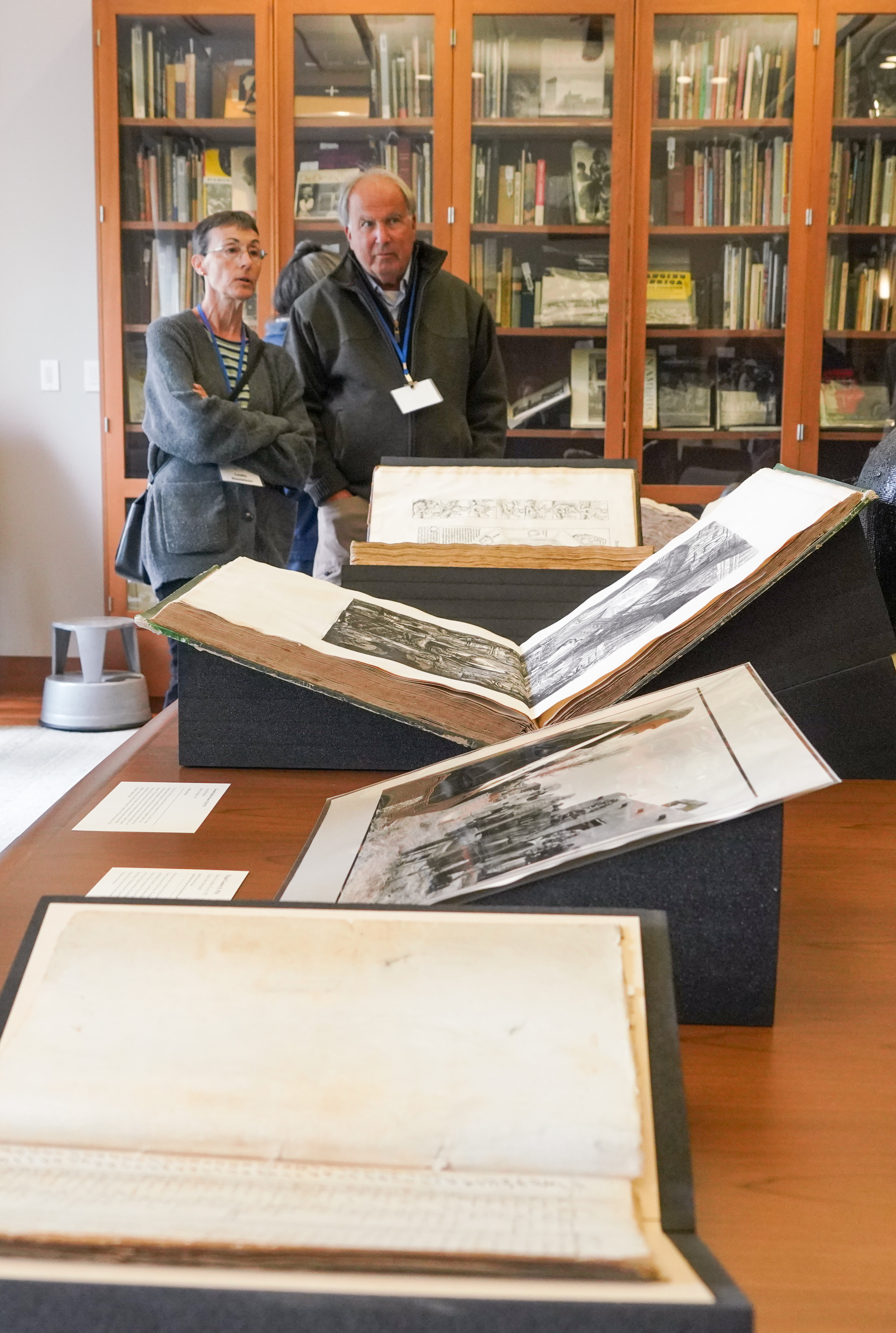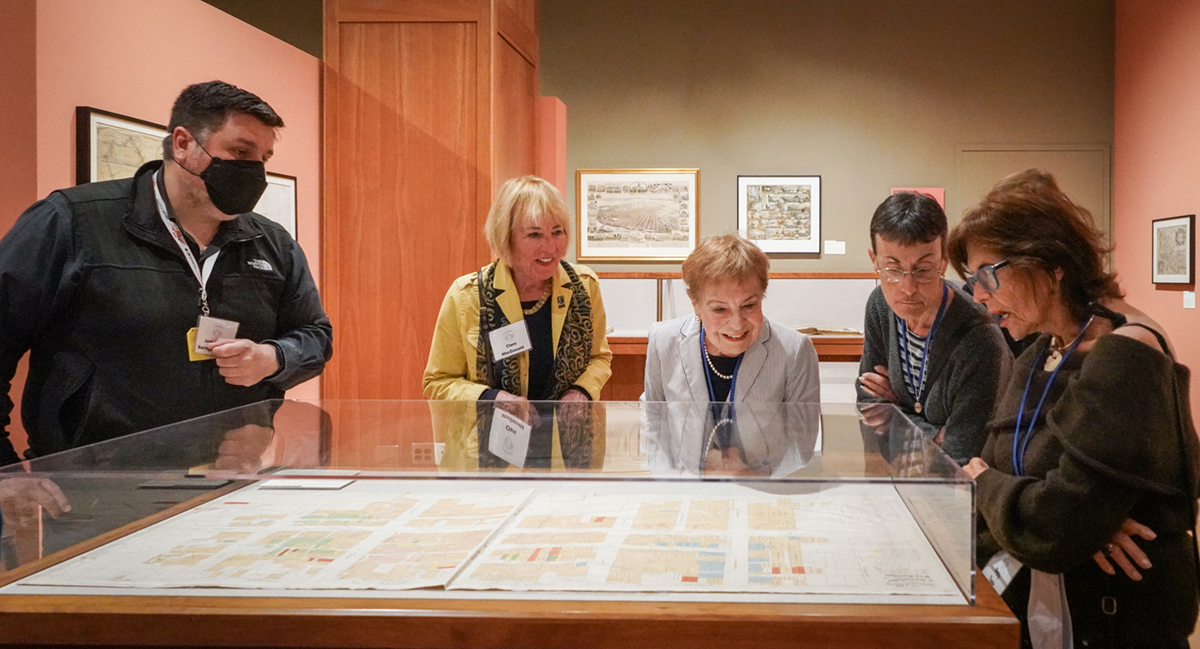

Top to bottom: Left to right: Michael Rodriguez looks at the description of an Oski mask during the Library Legacy Circle event; a copy of a landmark book by Delilah L. Beasley, published in 1919, is on display. (Photos by Jami Smith/UC Berkeley Library)
Last week, supporters of the UC Berkeley Library got in touch with history — literally. Nearly 40 honored guests got to hold, examine, and thumb through an array of exquisite historical items from The Bancroft Library’s special collections.
“When you can actually touch the materials, you feel a real connection with what you’re seeing,” said Albert Danielson ’72. “The history comes alive.”
Danielson and his wife, Leslie, were among those who participated in the event, which celebrated members of the Library Legacy Circle of The Benjamin Ide Wheeler Society. The group comprises people who have remembered the Library in their estate plans.
Leslie Danielson said it was nice to be back in person. The Danielsons attended several of the annual events prior to the pandemic, and were excited to be with the group again.

Among the 11 curator-selected items on display in the Bancroft seminar room was a painting that caught Leslie Danielson’s eye. The work depicts a kitchen in San Francisco’s Chinatown neighborhood in 1902. “It fascinated me to see what it was like at that time in Chinatown,” she said. “(The painting) spoke to me.”
The image is from a series of 13 created by Charles Albert Rogers just a few years before the 1906 earthquake. Much of Chinatown was destroyed in the disaster, as was Rogers’ studio, making the painting — and the historical moment it captures — even more essential.
Christine Hult-Lewis, Bancroft’s interim pictorial curator, who led this portion of the event, introduced guests to each of the extraordinary items on display. They included a copy of a landmark book by Delilah L. Beasley, published in 1919, which was the first work to document the history of African Americans in California. Beasley was the first African American woman in California to write regularly for a major metropolitan newspaper.
A gorgeous journal from the Gold Rush era, handwritten by Luther Fisher, recounts the man’s sea voyage from Boston to San Francisco to work in California’s gold fields. The 1849 diary contains two passenger lists, and observations about the weather and events aboard the ship.
An Oski head, from circa 1950 — one of four of the beloved Cal mascot’s costume heads held in the University Archives — also claimed a spot in the presentation.
In her introductory remarks, Kate Donovan, the director of Bancroft, emphasized the importance of keeping special collections available to all people.
“We collect these amazing things so that they can be used by you, and your grandchildren, and … generations down the road, in ways that we can’t even imagine today,” she said.
“That’s what we’re about at The Bancroft Library. And we couldn’t do it without your support.”

Legacy Circle members also got a tour of the much-heralded exhibit Visualizing Place: Maps from The Bancroft Library, which is on display through June. José Adrián Barragán-Álvarez, Bancroft’s curator of Latin Americana, led the tour.
Among the magnificent maps on display are several devoted to exploring Mexico’s evolution from colony to nation. A selection of maps, for example, depicts battlefields during the Mexican-American War (1846-48). “One of the things that’s really interesting to point out in this (1847 map of Mexico from J. Disturnell) is that the American Army used the exact same route that (Spanish conquistador Hernán Cortés) had used 300 years before to invade Mexico,” Barragán-Álvarez noted.
Talking to experts such as Barragán-Álvarez and Hult-Lewis is what sets these events apart, according to Albert Danielson.
“When you leave these presentations, you’ve actually learned something,” he said. “They want to leave you with thoughts in your mind, so … the next couple of days you’ll be thinking about some of the stuff you saw.”